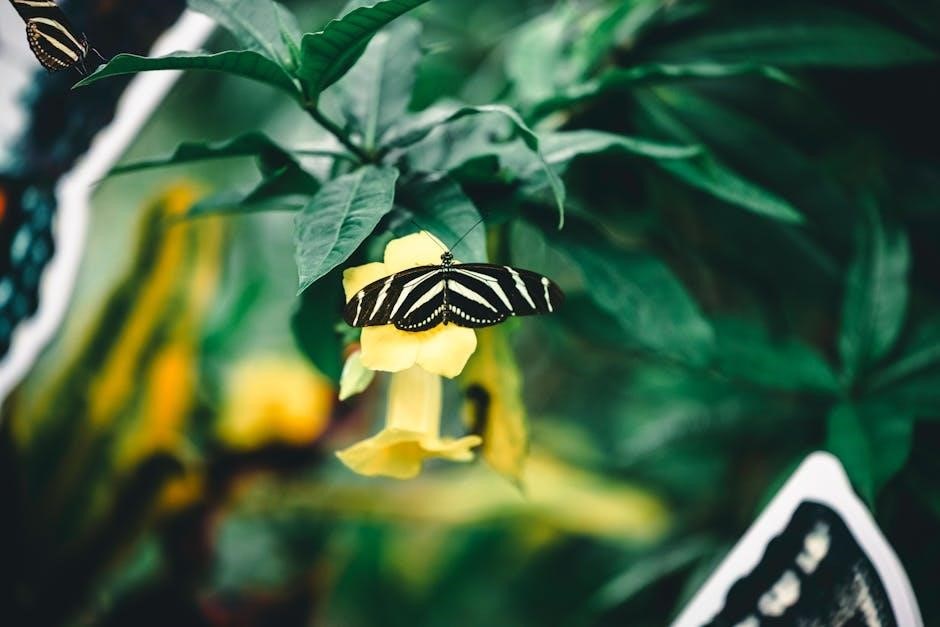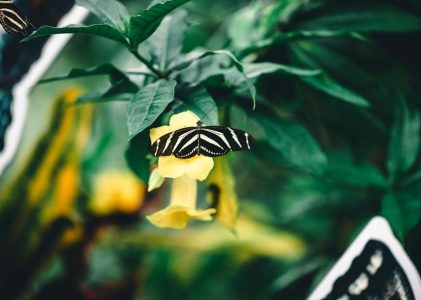The National Geographic Butterfly Kit offers an engaging and educational experience‚ allowing children to observe the magical transformation of caterpillars into butterflies. Includes habitat‚ caterpillars‚ and feeding tools for a comprehensive learning journey.
Overview of the Kit and Its Educational Value
The National Geographic Butterfly Kit is a comprehensive educational tool designed to teach children about the life cycle of butterflies. It includes a habitat‚ a voucher for live caterpillars‚ feeding tools‚ and instructional materials. The kit offers a hands-on learning experience‚ allowing kids to observe metamorphosis firsthand. With detailed guides and visuals‚ it simplifies complex biological concepts‚ making science accessible and engaging. Its durable design ensures long-term use‚ while the included stickers add a creative element to the learning process.
Key Components Included in the Kit
The National Geographic Butterfly Kit includes a mesh butterfly habitat with a see-through lid‚ a voucher redeemable for five live caterpillars‚ a flower-shaped feeder‚ and a sponge for feeding. It also contains flower-petal stickers for decoration‚ a plastic specimen dish‚ and a detailed Learning Guide with instructions and a full-color poster about butterfly anatomy and life cycles. These components provide everything needed to create a nurturing environment for caterpillars and observe their transformation into butterflies‚ making it an ideal educational tool for kids.
Unboxing and Preparing the Butterfly Habitat
Unboxing the Butterfly Kit reveals a mesh habitat‚ flower-petal stickers‚ feeder‚ and sponge. Assemble by placing the feeder and sponge‚ then decorate with stickers for an inviting space.
Step-by-Step Instructions for Setting Up the Habitat
Begin by unpacking all components‚ including the mesh habitat‚ feeder‚ sponge‚ and flower-petal stickers. Attach the feeder to the habitat’s base and place the sponge inside. Position the feeder in the center of the habitat for easy access. Decorate the habitat using the flower-petal stickers for an attractive display. Gently secure the habitat’s lid to ensure proper ventilation. Finally‚ place the habitat in a safe‚ stable location away from direct sunlight and drafts to create an ideal environment for your butterflies.
Decorating the Habitat with Flower-Petal Stickers
The kit includes flower-petal stickers to creatively personalize your butterfly habitat. Begin by peeling the stickers from the sheet and applying them to the flower-shaped feeder dish. This adds a vibrant‚ welcoming touch for the butterflies. Arrange the stickers in a pattern that mimics real flowers to create a natural environment. Once decorated‚ place the feeder dish in the center of the habitat‚ ensuring the feeding solution and sponge are securely positioned. This step enhances both functionality and aesthetic appeal‚ making the habitat more inviting for your emerging butterflies.
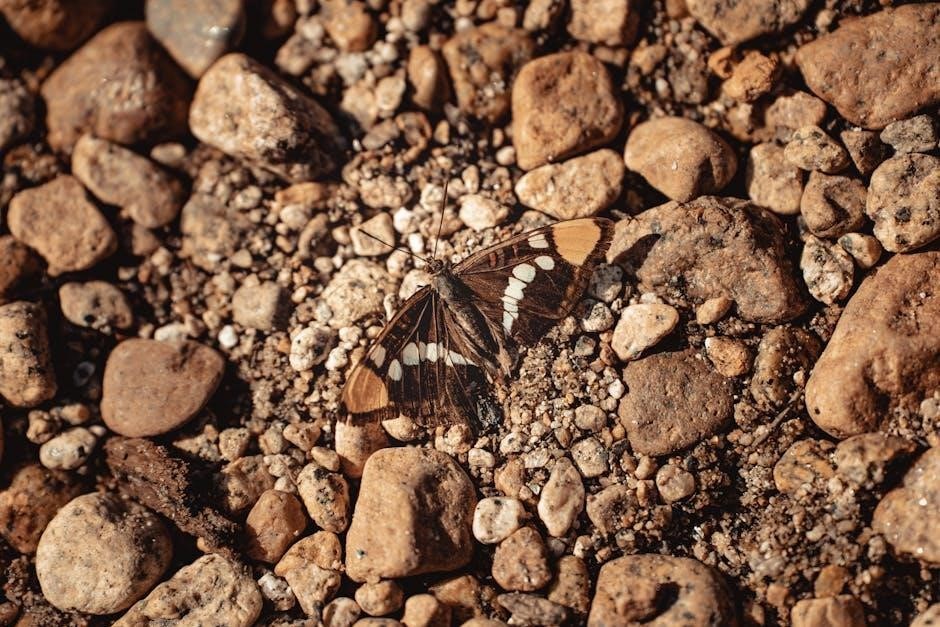
Obtaining and Caring for Caterpillars
Redeem the voucher for live caterpillars‚ then mail it to receive your specimens. Place caterpillars in the habitat with provided food‚ ensuring a safe environment for growth.
How to Redeem the Voucher for Live Caterpillars
To obtain live caterpillars‚ carefully fill out and mail the voucher included in the kit; Ensure all details are legible to avoid delays. Shipping and handling fees apply. Once processed‚ caterpillars are shipped directly to your address‚ typically within a few weeks. Follow the enclosed instructions for introducing them to their habitat. Contact customer support if issues arise during redemption. This step is crucial for starting the butterfly life cycle observation experience.
Basic Care Instructions for Caterpillars
Place caterpillars in the provided habitat immediately upon arrival. Keep the environment clean by gently removing frass daily. Provide fresh food as instructed‚ ensuring proper humidity and airflow. Maintain room temperature (65-75°F) and avoid direct sunlight. Do not disturb the caterpillars excessively‚ as they need a calm environment to grow. Observe their progress closely but handle them minimally. Follow the feeding schedule outlined in the guide for optimal growth. Proper care ensures a healthy transformation into chrysalises and‚ eventually‚ beautiful butterflies.
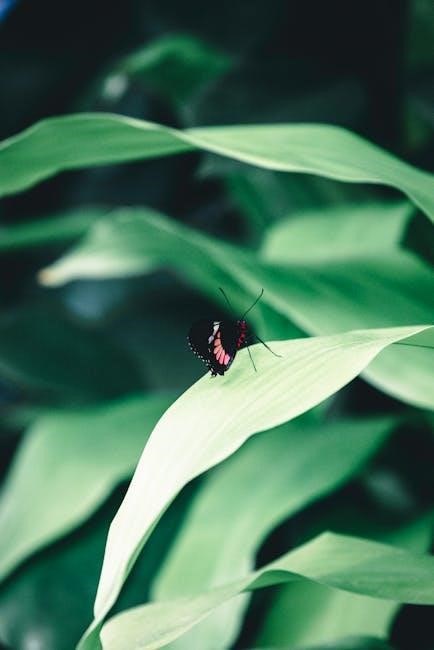
Feeding and Maintenance
Dissolve 1 teaspoon of sugar in water to create a feeding solution. Use the feeder and sponge to provide sustenance‚ ensuring butterflies stay nourished and hydrated.
Preparing the Feeding Solution for Butterflies
To prepare the feeding solution‚ dissolve 1 teaspoon of sugar in water to create a simple yet effective nourishment source for the butterflies. Place the solution in the provided flower-shaped feeder dish‚ ensuring the sponge is saturated but not soaking wet. Position the dish and sponge in the center of the butterfly habitat to mimic natural nectar sources. This setup allows the butterflies to feed easily without drowning. Regularly refresh the solution to prevent mold growth and ensure the butterflies stay healthy and energized throughout their life cycle.
Using the Feeder and Sponge Effectively
Place the flower-shaped feeder dish in the center of the butterfly habitat‚ ensuring it’s easily accessible. Soak the sponge in the prepared sugar solution and position it in the dish. The sponge should be moist but not dripping to prevent drowning. This setup mimics natural nectar sources‚ allowing butterflies to feed comfortably. Regularly refresh the solution to maintain freshness and hygiene. Proper use of the feeder and sponge ensures the butterflies receive adequate nourishment‚ promoting their health and vitality during their life cycle.
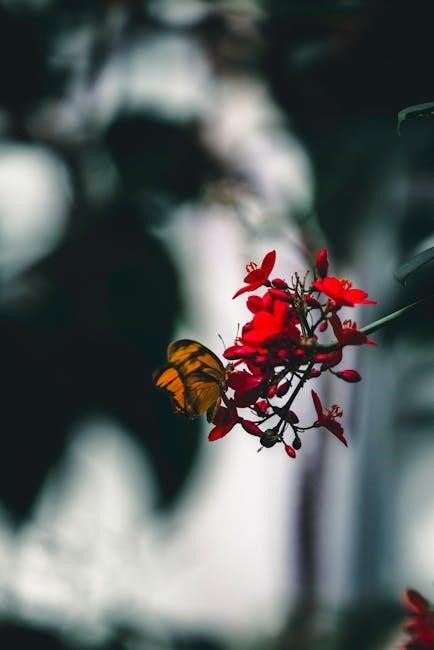
Observing the Metamorphosis
Witness the magical transformation of caterpillars into butterflies‚ observing each stage of their life cycle. This process typically takes 3 weeks‚ inspiring wonder and patience in children.
Understanding the Life Cycle of Butterflies
The life cycle of butterflies includes four stages: egg‚ larva (caterpillar)‚ pupa (chrysalis)‚ and adult. This process‚ called metamorphosis‚ typically takes 3 weeks. The caterpillar hatches from the egg‚ eats‚ and grows before forming a chrysalis. Inside‚ it transforms into a butterfly‚ which emerges‚ pumps blood into its wings‚ and flies. The National Geographic Butterfly Kit provides a detailed poster and guide to help kids understand this fascinating journey‚ making it an engaging learning experience about nature and transformation.
Monitoring the Transformation from Caterpillar to Chrysalis
Observing the caterpillar’s transformation into a chrysalis is a fascinating process. Daily monitoring reveals how the caterpillar attaches itself‚ forms a chrysalis‚ and undergoes dramatic changes. This stage typically lasts 7-10 days. Ensure the habitat remains upright and stable to prevent the chrysalis from falling. Keep the environment at room temperature and avoid disturbing the chrysalis. Patience is key as nature unfolds. The National Geographic Butterfly Kit’s guide provides insights into recognizing signs of successful transformation‚ making it an educational and captivating experience for children and adults alike.
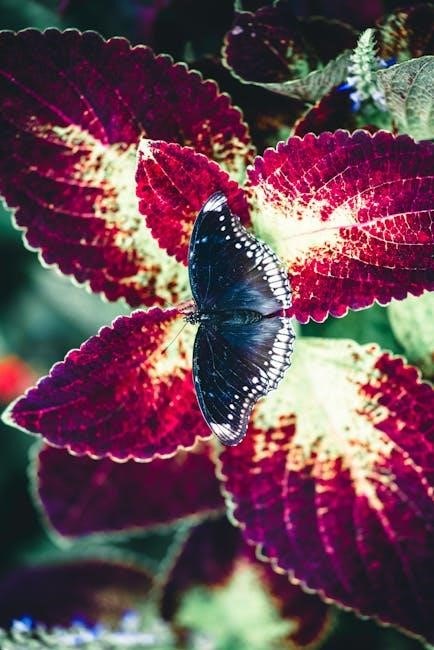
Common Questions and Troubleshooting
If a chrysalis falls‚ handle it gently and reattach it to a secure spot in the habitat. Ensure the area is stable and safe. Contact customer support if issues persist.
What to Do If a Chrysalis Falls
If a chrysalis falls‚ gently pick it up and reattach it to a secure spot in the habitat using a small pin or a drop of sugar water. Ensure the area is stable and free from drafts. If the chrysalis appears damaged‚ monitor it closely. Contact National Geographic customer support for guidance if the issue persists. Proper handling and reattachment can still allow the butterfly to emerge successfully‚ ensuring a positive outcome for this natural wonder.
Tips for Ensuring Successful Metamorphosis
To ensure a successful metamorphosis‚ maintain a stable environment with consistent temperatures between 65-75°F and avoid direct sunlight or drafts. Gently mist the habitat with water daily to maintain humidity. Avoid disturbing the chrysalis or caterpillars excessively‚ as this can disrupt the process. Provide fresh food and a clean habitat to promote healthy growth. Follow the instructions carefully and monitor the transformation closely. Proper care and attention will help your caterpillars thrive and emerge as beautiful butterflies‚ making the experience both educational and rewarding.
Releasing the Butterflies
After butterflies emerge‚ wait 2-3 hours before releasing them in a safe‚ natural area. Ensure the environment is free from predators and ideal for their survival.
When and How to Safely Release the Butterflies
Release butterflies in a safe‚ natural area with ample space and flowers for nectar. Choose a calm‚ sunny day with temperatures above 60°F to ensure their comfort. Gently handle the butterflies‚ ensuring their wings are fully dry and sturdy. Avoid releasing at night or in bad weather. Select a location free from predators and chemicals. Follow local regulations and release near flowers to provide food. This step completes their life cycle and allows them to thrive in their natural habitat.
Post-Release Care for the Habitat
After releasing the butterflies‚ clean the habitat thoroughly. Remove and wash the feeding dish and sponge with mild soap. Allow all components to air dry before storage. Discard any perishable items like food remains. The mesh cage can be reused for future caterpillars with proper cleaning; Ensure all parts are dry to prevent mold growth. Store the habitat in a cool‚ dry place to maintain its quality for next use.
The National Geographic Butterfly Kit provides an enriching‚ hands-on learning experience‚ fostering curiosity and wonder in children as they explore nature’s magic through butterfly metamorphosis.
Final Thoughts on the National Geographic Butterfly Kit Experience
The National Geographic Butterfly Kit delivers a fascinating and educational experience‚ offering a unique opportunity to witness metamorphosis up close. With durable materials and kid-friendly instructions‚ it sparks curiosity and learning. The inclusion of creative elements like flower-petal stickers adds fun to the process. Users praise its well-designed habitat and excellent customer support. Overall‚ it’s a memorable and enriching activity for children‚ fostering a deeper appreciation for nature and science. Highly recommended for families and educators seeking engaging‚ hands-on learning experiences.
Educational Benefits and Fun for Kids
The National Geographic Butterfly Kit provides an interactive learning experience‚ teaching children about the life cycle of butterflies and their anatomy through detailed posters and guides. Kids enjoy the hands-on process of caring for caterpillars and observing their transformation into butterflies. The kit’s creative elements‚ like flower-petal stickers‚ add fun to the setup. It fosters curiosity‚ responsibility‚ and a connection to nature‚ making it an ideal educational tool for homeschooling or family activities. The experience is both entertaining and enriching‚ leaving a lasting impression on young learners.
